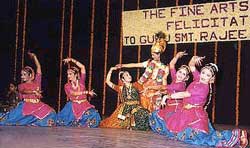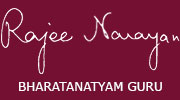REVIEWS
It was a matter of pride for all South Indians in general and those settled in Mumbai in particular, that the Government of Maharashtra had chosen to honour Guru Rajee Narayan with the Maharashtra Rajya Samskrutik Puraskar in the field of dance for 1996-1997. Though this lifetime achievement award was announced several months ago and was formally confered in April, only recently did the South Indians of Mumbai wake up to realise the significance of the award.
The Fine Arts Society, Chembur, stole a march over the other institutions in felicitating Rajee Narayan. In a function organised on 20 September, the Society presented her with a silver kuthuvilakku or the traditional oil lamp through the hands of the venerable natyacharya T. K. Mahalingam Pillai and a bouquet of flowers via Dr. Kanak Rele, the chief guests of the evening.
Instituted in 1976, the Rajya Samskrutik Award comprises a citation, a memento (a beautiful globe depicting India and Maharashtra, mounted on a pedestal with a small lamp) and 25,000 rupees in cash. There was a short spell of four years or so when the awards were discontinued before being re-instituted some 15 years ago.
The State cultural awards for lifetime acheivement in diverse categories, ranging from theatre to fold and classical arts, have always been given to Maharashtrians. The highest honour of the State received by Guru Rajee Narayan vindicates the contributions of all those of non-Maharashtrian origin who have made Mumbai and Maharashtra their home and who have become an intrinsic part of the city's life and culture. As Kanak Rele said, culture transcends language and religion and anyone who has enriched the cultural life of the State ought to be recognised for his or her contribution. She said that, in her 30 years of association with Rajee Narayan, she has found her to be a very self-effacing person who never pushed herself to the front and hence very few people knew her great qualities.
Guru Mahalingam Pillai, who spoke of Rajee Narayan's several achievements as a Bharatanatyam teacher, musician, composer and so on, drew particular attention to her work with the physically disabled children in presenting Nandanar Charitram a few years ago.
Rajee Narayan has been teaching Bharatanatyam and Carnatic music for over 45 years and can be counted amongst the handful who teach both these arts. She is also the only one in Mumbai to conduct classes for nattuvangam and many are those who have availed of her teaching. She has several compositions in several languages to her credit and is a choreographer also. She has two publicaions - Nritya Geeta Mala, consisting of two complete margam-s of her compositions for Bharatanatyam, and Natya Sastra Mala. A second volume of Nritya Geeta Mala with more of her compositions is on the anvil
Rajee Narayan established her institution Nritya Geethanjali in 1965, when she migrated to Mumbai. Branches of the institution have since been established in Australia, Canada and the U.S. headed by her disciples. In recognition of her knowledge and experience, she was appointed a member of the dance faculty of the Mumbai University, a post she has held for over 20 years. She has also been a paper-setter and examiner for the BFA and MFA courses of the University through the years.
After the felicitation function, there was a solo recital by Rajee Narayan's talented disciple Radhika Ramani who presented some of her guru's compositions. This was followed by a ballet, Radhey ka Shyam, composed in Hindi by the guru and presented by some of her senior disciples.
What attracted many members of the audience, comprising other guru-s and aficionados, was the melodious singing of the first few phrases of the particular item by the dancers themselves. The dancers had been trained in Carnatic music also by Rajee Narayan.
The one jarring note in the proceedings was the announcement by the organisers that the others who had turned up to felicitate the guru on the occasion should do so backstage as they did not wish to delay the dance recital. When the evening had been announced as an event to felicitate a respected guru, it would have been only fair and gracious to let others (invitees all) to publicly express their appreciation. It is another thing altogether that a few managed to come up on stage and present their bouquets or shawls before the curtains closed on them. One hopes FAS will take note of this in future, for it has always displayed professionalism in conducting programmes.
K. Subadra Murthy 1998. Sruti



